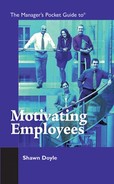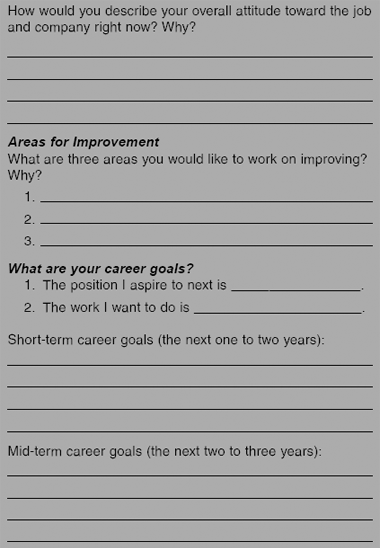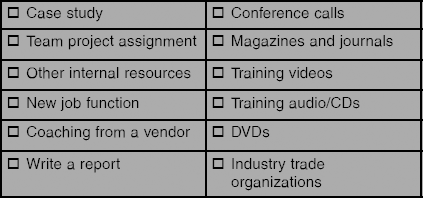The Growth and Development Meeting
For all employees on the team, the growth and development meeting should be the cornerstone of commitment to their development. The meeting is a minimum of one hour every year in order to discuss the employee’s areas of strengths and areas for improvement. This is not to be confused with the annual review. The annual review is a meeting with a report stating how the employee performed; the growth and development meeting is a dialogue where four areas are discussed at length:
(1) strengths from the employee’s and the manager’s views, (2) areas to improve from the employee’s and the manager’s view, (3) career goals short, mid, and long term, (4) how they can get there using the tool called the growth and development plan created by the employee and manager. There are several advantages to holding such a discussion:
• It is very motivating because the employee gets to talk about their favorite subject—themself!
• If the manager handles it well, it can result in very meaningful dialogue.
• It encourages the employee to step back and think about his/her career.
• It builds a track for the manager and the employee to run on for the year.
The manager and the employee will each need to prepare for the meeting. The manager should ask the employee to do a self-assessment that will help the employee and the manager structure the discussion and focus on the employee’s future

What skills need to be developed?
How can the skills be developed?
The growth and development meeting is the most important meeting of the year relating to employee development. The manager should give the meeting his/her full and undivided attention. That means the meeting should be private and uninterrupted, and the manager should not be multi-tasking out of respect for the employee. If the work environment makes that impossible, then the manager should set up the meeting off site. If the meeting is a commitment to the employee’s development, then the logistics should indicate the importance of the commitment. The manager should set the stage for the meeting by properly positioning it for the employee and helping him/her to understand the purpose of the meeting.
Here is an example:
“Well, Jim, I am glad we could meet today and this is the most important meeting we will have because it is about your development. The purpose of today’s meeting is to talk about your strengths, areas for improvement, and then your short-, mid-, and long-term goals. Then we will discuss what we can do to help get you there. I want to make sure that we have plenty of open and honest dialogue, so please feel free to tell me your thoughts.”
The manager will then go through all the elements of the meeting:
• Discuss the employee’s strengths. Ask the employee to review their strengths first. This sets the stage psychologically, because the information is coming from the employee first. It also gives the manager a chance to get the employee’s views on strengths first. The manager should then review what they think the strengths are for that employee. The idea is to have a valuable dialogue and to provide plenty of specific examples. Once both parties reach mutual agreement, the next topic can be covered.
• Discuss areas for improvement. The discussion then turns to areas for improvement. Just as on the strengths section, the manager should have the employee review his/her areas for improvement. This should be a constructive discussion, and the manager should avoid being critical. The tone set will allow for increased understanding and dialogue.
• Review career goals. The employee should next review his/her career goals. In the ideal world, the employee will always know what he/she wants. However, there are many employees who don’t know what they want. In that case, the manager should try to have dialogue to get the employee to start to think about what they want. The manager should not under any circumstances try to steer the employee toward any conclusion. Let’s say a manager thinks that an employee would be great for management. In the opening discussion of the career goals section, the employee indicates an intense desire not to be in management. It would be counterproductive then for a manager to try to influence that employee in that direction. Next the manager will get the employee to talk about mid- and long-term goals. The key in this area is for the manager to really listen and take notes. This indicates to the employee that what they say is important. Managers must always back up what they say by what they do, otherwise there is a mixed message. It is then time to move to the all-important individual growth and development plan.
• Create an individual growth and development plan (IGDP). This is the most important part of the meeting, because this is when the specific action is determined and decided upon between the manager and the employee. The manager should ask the employee their specific ideas first as to what they can do to develop their knowledge and skills. Managers get better buy-in from the employee when they are involved in developing the plan. The plan should be specific and measurable, and have a timeline in mind. The manager will then follow up later to discuss progress. At times, the IGDP can be too complex to develop at the meeting, and a subsequent meeting might be required. There are times when managers know what the employees need, but are at a loss for resources. It is a good idea for managers to talk to the training function in their company and the Human Resources Department, as well. There is also a tendency for managers to think of only formal training for someone to gain a skill. Many approaches are available that might not be the standard classroom training. A checklist of possible resources is provided on the next page in order for the manager and employees to refer to for ideas. Development doesn’t have to be expensive; there are many low- or no-cost methods on the checklist.
People we meet often talk about “dead end jobs.” The distinct advantage of doing a growth and development meeting and an individual growth and development plan with each team member is that they are then taken out of the dead end job mindset because they can grow and have a possibility for advancement. The fact that the manager took the time and energy to meet with him/her is motivating, and the meeting gives him/her an idea that there is a future to work toward.





